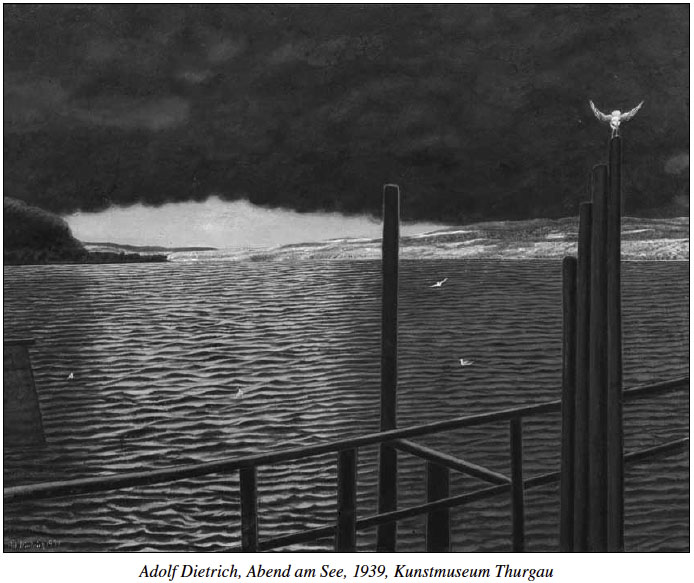The pictures tell us: “We want peace, not war!”

The beautiful former Carthusian monastery from the 15th century is embedded in the idyllic Thur countryside. In 1977, the buildings, the large garden and the Baroque church were exemplarily refurbished, redeveloped and enlarged under the motto “maintain and revitalize” by the Canton Thurgau to become a cultural center. Until today, the Monastery is still the pride of the Canton. It is home to the Museum, guest houses and seminar rooms along with a large organic farm and a shop as well as a bookbindery and a restaurant in the old mill. “The operating concept is based on monastic values, culture, spirituality, education, care, hospitality and self-sufficiency.” There are more than sixty men and women working in the vineyards, the dairy, in agriculture and forestry and plant nursery.
Art, ethics, human sympathy and humanitarian assistance
The current exhibition in the unique, atmospheric and intimate museum rooms at the Art Museum has borrowed its title from a landscape painting by Adolf
Dietrich. The artist has captured the intense evening moods at the “Untersee” (a part of Lake Konstanz) in numerous pictures. The 1939-work marked the beginning of the exhibition. A vision, right before the outbreak of war. It shows an almost black sky, on the horizon though a fiery-red sky that seems to be on fire. Thus, the dark, harsh and strained situation of the population in the East of Switzerland during the 2nd World War is intuitively accessible. It is deserving that the “Kunstmuseum Thurgau” largely arranged the exhibition to the major part out of their own large collection. Many pieces of art have been rarely shown to date. Therefore, it was possible to also honour great works of forgotten and underestimated artists. There are mostly painters of realism, who dealt “with the terrible reality of near war” by means of various techniques, each in his own way. An issue that is very up to date! In the individual rooms impressive works and artists are presented thematically, showcases with documents and explanatory text panels show biographical and historical references. The museum director Markus Landert writes and explains: “Times of war hit artists hard. Who actually thinks of art, when life and existence are threatened? Even though Switzerland remained untouched during the Second World War, the situation for the population was not easy. Food shortage, refugee flows, but also the uncertain news situation determined everyday life in the country.”
There are pictures by famous artists like Frans Masereel, with an extensive and impressive linoleic sequence on the insanity of war. Likewise, we find many excellent works by painters and artists from Eastern Switzerland like Carl Walter Liner, Ernst Graf, or Carl Roesch. Touching photographs by Hans Baumgartner about the daily routine of war and by Theo Frey with his famous recordings of the “Rütli rapport” with General Guisan and the refugee flows through Switzerland. The Swiss population and the Red Cross provided exemplary humanitarian aid. They helped the German war-stricken children and families across the lake. Also, the works of the critical Appenzeller illustrator Carl Böckli, known as “Bö”, for the opposition magazine “Nebelspalter”. The monumental 92-part work by Jakob Greuter is a discovery. A simple, intelligent and compassionate worker, an “empty out bucketeer” at the St Gallen garbage collection, as autodidact, independently elaborated and artistically and passionately depicted the whole war situation, based on magazines, photographs, drawings and texts. Even the artist Hedwig Scherrer, who with her striking pictures and texts has denounced the “murder industry” (1934–35), is hardly represented in usual exhibitions.
The exhibition is on view until 30 August 2015. The entire museum and the monastery is well worth seeing and in every respect a worthwhile trip. In the basement of the museum an excellent work of concept art by the American artist Joseph Kosuth is accessible. In the stone floor, he has enlarged and engraved a page of the former handwritten list of books in the monastery library, which was destroyed during the Reformation. •
Information: “Kunstmuseum Thurgau”, Charthusian Monastery Ittingen, CH 8532 Warth
Open:
Mon to Fri 14 to 17
Sat and Sun 11 to 17
Tel. (0) 58 345 10 60
E-mail: <link>sekretariat.kunstmuseum@tg.ch
Homepage: <link http: www.kunstmuseum.ch>www.kunstmuseum.ch